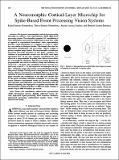Por favor, use este identificador para citar o enlazar a este item:
http://hdl.handle.net/10261/7823COMPARTIR / EXPORTAR:
 SHARE SHARE
 CORE
BASE CORE
BASE
|
|
| Visualizar otros formatos: MARC | Dublin Core | RDF | ORE | MODS | METS | DIDL | DATACITE | |

| Título: | A neuromorphic cortical-layer microchip for spike-based event processing vision systems |
Autor: | Serrano-Gotarredona, Rafael CSIC; Serrano-Gotarredona, Teresa CSIC ORCID ; Acosta, Antonio J. CSIC ORCID; Linares-Barranco, Bernabé CSIC ORCID | Palabras clave: | 2-D convolutions Address Event Representation (AER) Bio-inspired systems High-speed signal processing MOS transistor mismatch Spike-based processing Subthreshold circuits VLSI |
Fecha de publicación: | 16-oct-2006 | Citación: | IEEE Transactions on Circuits and Systems I: Regular Papers 53(12): 2548-2566 (2006) | Resumen: | We present a neuromorphic cortical-layer processing microchip for address event representation (AER) spike-based processing systems. The microchip computes 2-D convolutions of video information represented in AER format in real time. AER, as opposed to conventional frame-based video representation, describes visual information as a sequence of events or spikes in a way similar to biological brains. This format allows for fast information identification and processing, without waiting to process complete image frames. The neuromorphic cortical-layer processing microchip presented in this paper computes convolutions of programmable kernels over the AER visual input information flow. It not only computes convolutions but also allows for a programmable forgetting rate, which in turn allows for a bio-inspired coincidence detection processing. Kernels are programmable and can be of arbitrary shape and arbitrary size of up to 32 32 pixels. The convolution processor operates on a pixel array of size 32 32, but can process an input space of up to 128 128 pixels. Larger pixel arrays can be directly processed by tiling arrays of chips. The chip receives and generates data in AER format, which is asynchronous and digital. However, its internal operation is based on analog low-current circuit techniques. The paper describes the architecture of the chip and circuits used for the pixels, including calibration techniques to overcome mismatch. Extensive experimental results are provided, describing pixel operation and calibration, convolution processing with and without forgetting, and high-speed recognition experiments like discriminating rotating propellers of different shape rotating at speeds of up to 5000 revolutions per second. | Versión del editor: | http://dx.doi.org/10.1109/TCSI.2006.883843 | URI: | http://hdl.handle.net/10261/7823 | DOI: | 10.1109/TCSI.2006.883843 | ISSN: | 1549-8328 |
| Aparece en las colecciones: | (IMSE-CNM) Artículos |
Ficheros en este ítem:
| Fichero | Descripción | Tamaño | Formato | |
|---|---|---|---|---|
| neuromorphic cortical.pdf | 4,2 MB | Adobe PDF |  Visualizar/Abrir |
CORE Recommender
SCOPUSTM
Citations
91
checked on 29-mar-2024
WEB OF SCIENCETM
Citations
80
checked on 19-feb-2024
Page view(s)
426
checked on 18-abr-2024
Download(s)
546
checked on 18-abr-2024
Google ScholarTM
Check
Altmetric
Altmetric
NOTA: Los ítems de Digital.CSIC están protegidos por copyright, con todos los derechos reservados, a menos que se indique lo contrario.
